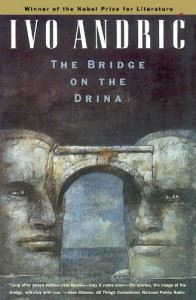The Bridge on the Drina by Ivo Andrić

This is a sort of fictionalized history, which the author referred to as a “chronicle” rather than a novel. It spans about 350 years in the history of Višegrad, Bosnia, telling the story of the town and its Ottoman-era bridge from the 16th century to World War I. The book dips into the lives of individual characters, usually for vignettes of a chapter or less, but focuses more on the general feeling or changes in the town and the reaction of townspeople in general to key events than on particular characters. There are some astute character sketches; Andrić seems to have a good understanding of human nature. But overall it is a sweeping history told much more in narrative summary than specific scenes, and the town and bridge themselves, rather than particular families or plot threads, provide continuity between chapters.
It is a well-written (or well-translated) book, though a dense and slow read that felt much longer than its 300 pages. There’s a melancholy atmosphere throughout, with time passing and empires marching on indifferent to the fates of individuals. Readers should know that in the first 60 pages there is a horrifically graphic impalement scene that I did not need in my head and that a few years from now may be all I remember about the book. I persevered only after learning that there are no other graphic torture scenes, though death is a frequent occurrence throughout.
It’s also worth pointing out that, although to English-speakers this may seem like timeless storytelling, Andrić – a Bosnian Serb who ultimately made his home in Belgrade – is a controversial figure in Bosnia, and some see the book as advancing an anti-Bosniak political agenda. To me, as an outside reader, he seems to treat the Muslim and Serb populations of Višegrad both with humanity and fairly evenhandedly, with the important caveat that the Muslim population is referred to as “Turks” and “Turkish” throughout. Based on a bit of online research, this is inaccurate: the Bosnians were Slavs who had their own Bosnian Kingdom prior to their conquest by the Ottoman Empire in 1463, after which most of the population converted to Islam. But a reader ignorant of the region’s history might take Andrić’s terminology to indicate that Bosnia’s Muslims were Turkish colonists or transplants and that the Serbs were the original population. It occurs to me now that the impalement might be another subtly political decision: no such detailed brutality is described from any rulers other than the Ottomans, and Andrić imbues this scene with the maximum body horror, at a time when graphic violence in media was likely much less common than it is now (the book was published in 1945). Surely he knew how much this would stick out in readers’ minds.
Overall, the book did teach me something of the history of the Balkans, and presents a plausible chronicle of how history was experienced by everyday people over the course of hundreds of years. While I struggled a bit to get through it, I wouldn’t discourage readers who enjoy this sort of thing.
 1
1





